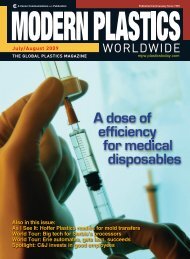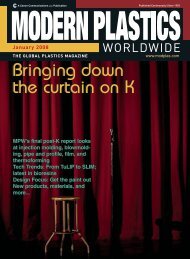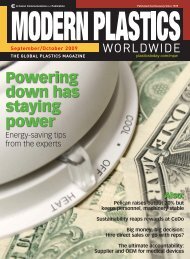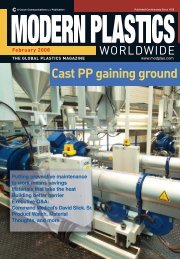amidiq - dae uptlax
amidiq - dae uptlax
amidiq - dae uptlax
Create successful ePaper yourself
Turn your PDF publications into a flip-book with our unique Google optimized e-Paper software.
J. Romero-González et al. / Revista Mexicana de Ingeniería Química Vol. 6, No. 3 (2007) 295-300<br />
Table 4. Freundlich and Langmuir isotherm parameters for the biosorption of Pb(II) onto Agave tequilana Weber<br />
biomass at 24±2 o C and pH 5.0<br />
Freundlich Langmuir<br />
Metal<br />
KF·10 -2<br />
mol·g -1<br />
n R 2<br />
QL·10 -2<br />
mol/g<br />
b·10 -2<br />
dm 3 ·mol -1<br />
Pb(II) 105.52 0.87 0.9675 0. 04 34.91 0.0221 0.1380<br />
ion adsorbed forming a complete monolayer on the<br />
biomass surface per mass of adsorbent biomass (mol<br />
g -1 ), and b is a constant related to the energy of<br />
adsorption (dm 3 mol -1 ). Ce is the concentration of the<br />
metal in the solution at equilibrium (mol dm -3 ). The<br />
Langmuir model is usually linearized as shown in<br />
Eq. (6). The biosorption data obtained for Pb(II), and<br />
were fitted into equation (2) by plotting Ce/qe versus<br />
Ce,<br />
Ce Ce<br />
1<br />
= + (6)<br />
qe QL bQL<br />
The dimensionless adsorption intensity (RL) is<br />
computed using the following equation (Lin and<br />
Juang, 2002).<br />
1<br />
RL<br />
=<br />
(7)<br />
( 1+<br />
bCo<br />
)<br />
where Co is the initial metal concentration in the<br />
solution (mol dm -3 ); RL indicates the type of<br />
isotherm; if it is irreversible RL = 0, favorable 0 < RL<br />
< 1, linear RL = 1, or unfavorable RL > 1.<br />
The adsorption behavior of the investigated<br />
metals onto the Agave azul was also fitted into the<br />
Freundlich isotherm. The Freundlich model is also a<br />
non-linear model that suggests a monolayer sorption<br />
of the metal on the biomass. Differing from the<br />
Langmuir, the Freundlich model assumes a<br />
heterogeneous energetic distribution of the active<br />
binding sites on the sorbate surface with interactions<br />
between the adsorbed molecules (Davis et al., 2003,<br />
Romero-Gonzalez et al., 2005a). In the Freundlich<br />
model, it is considered that the binding sites affinities<br />
on the biomass surface vary with the interactions<br />
between the adsorbed molecules. Consequently, the<br />
sites with stronger affinity are occupied first (Davis<br />
et al., 2003). The general equation and the linearized<br />
form for the Freundlich isotherm is expressed in eqs.<br />
(8) and (9) as follows,<br />
1/n<br />
qe = KFCe (8)<br />
ln qe = ln KF + 1/ nln Ce<br />
(9)<br />
In eqs. (8) and (9), KF is the maximum<br />
adsorption capacity (mol g -1 ), and n is the adsorption<br />
intensity, which is related to the affinity or binding<br />
strength (Davis et al., 2003). KF and 1/n are<br />
determined from the slope and intercept resulting<br />
from plotting ln qe versus ln Ce..<br />
The parameters obtained from fitting the<br />
Langmuir and Freundlich models onto the data<br />
obtained from the binding of Agave azul biomass<br />
with Pb (II) are presented in Table 4. As shown in<br />
Table 4, the correlation coefficient (R 2 ) obtained<br />
resulted from the Freundlich model was 0.9675 for<br />
Pb(II), while for the Langmuir model the R 2 value<br />
was 0.1380. This suggests that Agave tequilana<br />
Weber biomass sorbed Pb(II) following the<br />
Freundlich model (R 2 > 0.95). The result also<br />
suggests that the biosorption system of Agave azul<br />
biomass could have more than one functional group<br />
which is responsible for the metal binding such as it<br />
was suggested in the study of section 3.1, pH profile.<br />
The KF value obtained from the Freundlich<br />
model of 7.02 10 -2 mol g -1 for Pb(II). It was hard to<br />
compare the maximum capacity with many reported<br />
studies due to differences in experimental conditions<br />
and models used to fit the data in each study.<br />
However, under similar conditions, the maximal<br />
capacities of African alfalfa biomass were reported<br />
to be 0.081 . 10 -2 mol g -1 for Pb(II) (Gardea-Torresdey<br />
et al., 1998). In addition, it has been reported that the<br />
synthetic resin amberlite IR-120 has a maximal<br />
adsorption capacity of 1.96.10 -2 mol g -1 for Pb(II)<br />
(Demirbas et al., 2005). The results from the present<br />
study clearly showed that the Pb (II) binding<br />
capacity of Agave azul leaves biomass is higher than<br />
the reported capacity for African alfalfa biomass and<br />
the amberlite IR-120 synthetic resin.<br />
Conclusions<br />
The results of this study demonstrated that the<br />
Agave tequilana Weber leaves biomass has the<br />
potential for the removal of Pb (II) from aqueous<br />
solution. Although, the maximum adsorption<br />
capacity was obtained at pH 5 (93%). The adsorption<br />
process was found to be time-dependent. Adsorption<br />
isotherms showed that the adsorption pattern for Pb<br />
(II) followed the Freundlich isotherm. The<br />
adsorption capacity showed by Agave azul biomass<br />
was higher than the average values reported in the<br />
literature.<br />
Acknowledgment<br />
The authors would like to acknowledge financial<br />
support from the University of Guanajuato at México<br />
and the Programa de Mejoramiento del Profesorado<br />
(PROMEP) (Agreement PROMEP/103.5/04/2921).<br />
References<br />
Ahluwalia, S.S., Goyal, D. (2005). Removal of<br />
heavy metals by waste tea leaves from<br />
RL<br />
R 2<br />
299









